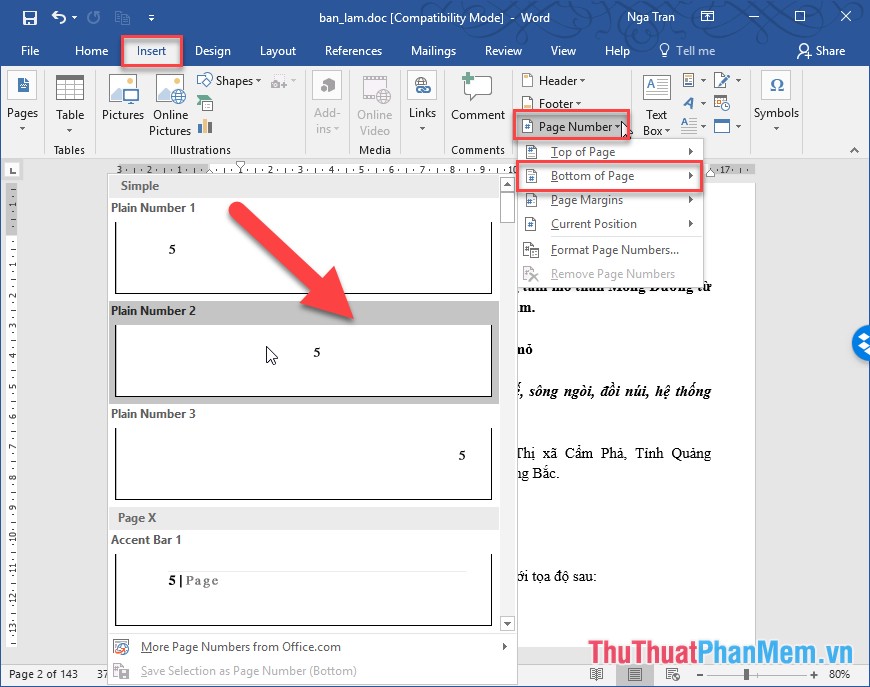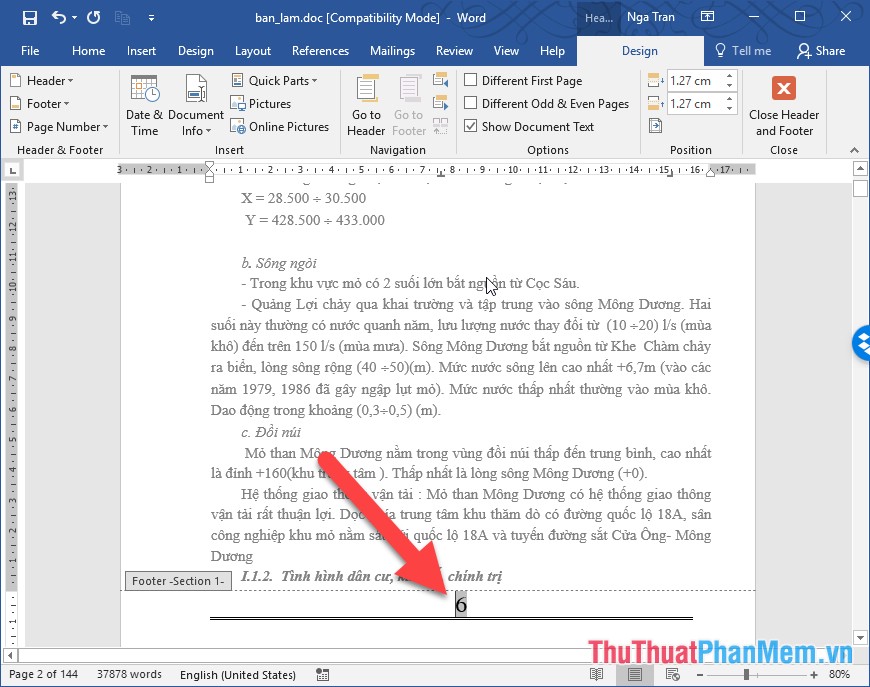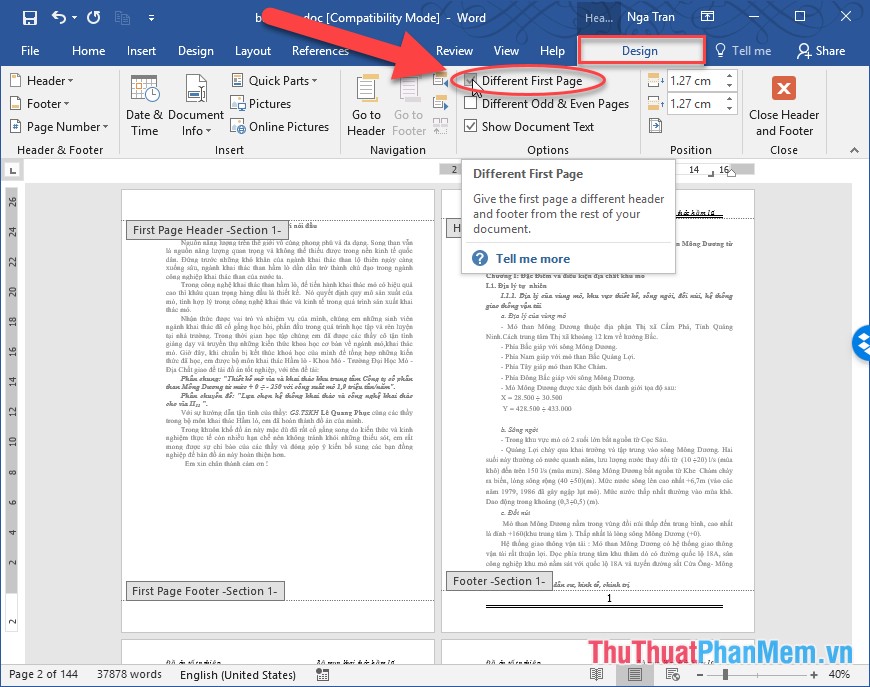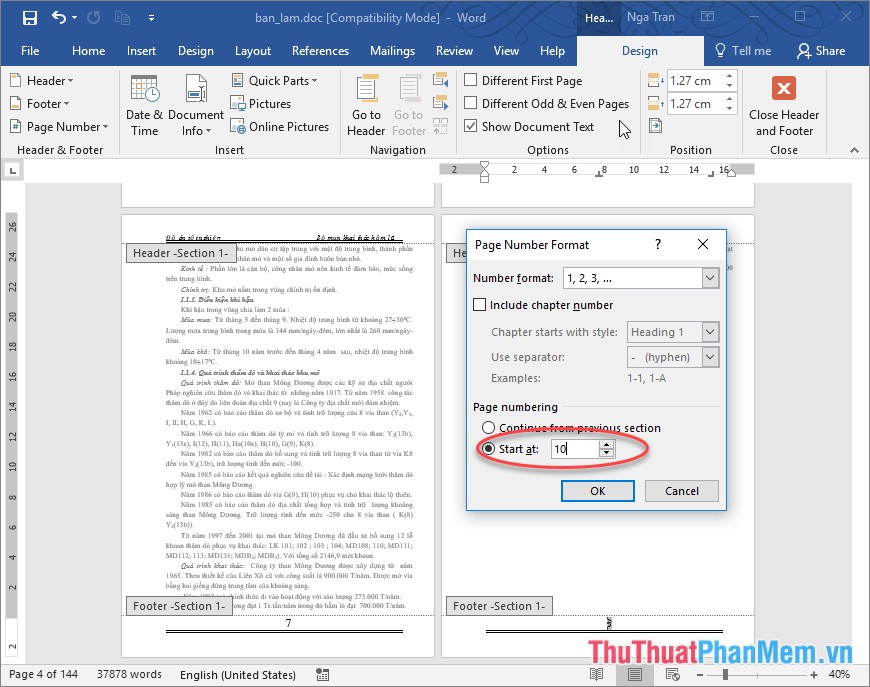Instructions for page numbering in Word, align page numbers, delete page numbers
The following is a guide to page numbering in Word, aligning page numbers, and deleting page numbers to help you locate and search easily in large documents.
1. Insert page number
Open the text file to insert page numbers -> on the Insert tab -> Page Number -> select the location to insert the page number, for example here choose Bottom of Page ( ie insert page number below the text) -> select select the location to insert:

Result of inserting page numbers at the end of the text:

After inserting the page numbers you want to align, the page number . click Design .
- For example, if you want the page number of the first page to be different from the rest of the pages, check the Different first page -> the first page is not numbered, because in an essay usually the first page does not have page numbers:

- Or want the first page and the last page as a table of contents without a page number, select Different Odd & Even page:

- Want to number the page starting from any value, click Design -> Page Number -> Format page Number:

Enter the start value you want to paginate in Start At -> click OK:

- To add text in the page number, click to enter, for example, from the page next to the page number:

3. Delete the page number
In case you do not want to insert page numbers in the implementation document into the Insert tab -> Header & Footer -> Page Number -> Remove Page Numbers

Or you can do so by highlighting the page numbers and pressing the Delete key or the BackSpace key all the page numbers are deleted:

Above is a detailed guide on page numbering in Word, align page numbers, delete page numbers.
Good luck!
You should read it
- How to type page numbers in Word 2016
- Word 2013 Complete Guide (Part 14): Page title, footer and page numbering
- How to number page combination i ii iii and 1, 2, 3 on Word
- Number pages from any page in Word 2016
- How to insert page numbers in Excel
- How to type pages in Word 2010
- How to number pages in Word 2007
- How to number a PDF page
May be interested
- Instructions for numbering pages from any page in Word quickly 2020
 instructions for page numbering from any page in word quickly 2020. if the word document has the first page is the table of contents .... that you only want to number the page from the beginning page with the document content, you need to do follow any of the page numbering instructions below.
instructions for page numbering from any page in word quickly 2020. if the word document has the first page is the table of contents .... that you only want to number the page from the beginning page with the document content, you need to do follow any of the page numbering instructions below. - How to number pages from any page on Word 2007,2010,2013
 tips to help you know the common page numbering in word. as well as page numbering from any page in the document. good luck!
tips to help you know the common page numbering in word. as well as page numbering from any page in the document. good luck! - The most effective way to number pages in Word 365 as desired
 page numbering in word 365 is an important task when you are drafting or doing a thesis on microsoft word tool. if you don't know how to number pages in word 365, please follow tipsmake's instructions below!
page numbering in word 365 is an important task when you are drafting or doing a thesis on microsoft word tool. if you don't know how to number pages in word 365, please follow tipsmake's instructions below! - Instructions for page numbering and tab settings for paragraphs in Word
 typing text with word is one of the most basic skill requirements, but with further editing, if you do not study well, you may not know.
typing text with word is one of the most basic skill requirements, but with further editing, if you do not study well, you may not know. - How to number a PDF page
 pdf page numbers are not available as options for page numbering in word or page numbering in excel.
pdf page numbers are not available as options for page numbering in word or page numbering in excel. - How to number pages in Excel very quickly and easily
 numbering pages in excel has many ways to do and insert many different types of excel page numbers. page numbering in excel will be fundamentally different from inserting page numbers in word.
numbering pages in excel has many ways to do and insert many different types of excel page numbers. page numbering in excel will be fundamentally different from inserting page numbers in word. - How to insert page numbers in Excel
 page numbering in excel differs from page numbering in word, we will need to customize the page setup group in excel.
page numbering in excel differs from page numbering in word, we will need to customize the page setup group in excel. - Number pages from any page in Word 2016
 the default page numbering will number from the first page to the last page. if you want to page numbers from any page, you need to do a few more steps, below is a detailed guide on how to get page numbers from any page in word.
the default page numbering will number from the first page to the last page. if you want to page numbers from any page, you need to do a few more steps, below is a detailed guide on how to get page numbers from any page in word. - MS Word - Lesson 15: Create an automatic number
 automatic sequence numbers allow you to format and organize text with numbers, bullets (round dots), or a border.
automatic sequence numbers allow you to format and organize text with numbers, bullets (round dots), or a border. - Any page numbering in Word
 regularly working with word editors, you probably know how to number pages for word documents. but for documents such as dissertations, blueprints, table of contents, opening or ending, it is not usually the page number of the page but only the page number.
regularly working with word editors, you probably know how to number pages for word documents. but for documents such as dissertations, blueprints, table of contents, opening or ending, it is not usually the page number of the page but only the page number.










 COVARIANCE.P function - The function returns the covariance of a set, the product of the average of degrees of instruction for each pair of data points in Excel
COVARIANCE.P function - The function returns the covariance of a set, the product of the average of degrees of instruction for each pair of data points in Excel COVARIANCE.S function - Returns the covariance pattern, the average of product deviations for each pair of data points in two data sets in Excel
COVARIANCE.S function - Returns the covariance pattern, the average of product deviations for each pair of data points in two data sets in Excel INTERCEPT function - The function returns the point at which the line will intersect the y-axis by using the existing x and y values in Excel
INTERCEPT function - The function returns the point at which the line will intersect the y-axis by using the existing x and y values in Excel MODE.SNGL function - Function that returns the most frequently occurring, or the most repeated values in an array or data range in Excel
MODE.SNGL function - Function that returns the most frequently occurring, or the most repeated values in an array or data range in Excel NORM.S.INV function - The function returns the inverse of the normalized distribution with an average value of 0 and a standard deviation of 1 in Excel
NORM.S.INV function - The function returns the inverse of the normalized distribution with an average value of 0 and a standard deviation of 1 in Excel PERCENTRANK.EXC function - The function returns the rank of a value in a dataset as a percentage excluding values 0 and 1 in Excel
PERCENTRANK.EXC function - The function returns the rank of a value in a dataset as a percentage excluding values 0 and 1 in Excel